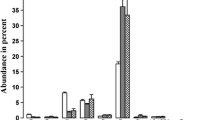Abstract
Laboratory-rearedSolenopsis invicta workers were tested for the ability to discriminate nestmates from nonnestmate conspecifics. Postcontact aggressive response to workers from local field colonies was significantly greater than the response to lab-reared workers, even when the latter were selected from colonies originating hundreds of miles away. Behavioral observations support the conclusion that lab-reared ants were less distinctive than field-collected ants with respect to recognition cues detectable on the cuticle. Potential environmental factors affecting colony odor are discussed. In addition, gas-liquid Chromatographic and statistical analyses of the majorS. invicta cuticular hydrocarbons indicate that cuticular hydrocarbon pattern was a poor predictor of laboratory colony response to field colony workers.
Similar content being viewed by others
References
Alexander, R.D. 1974. The evolution of social behavior.Annu. Rev. Ecol. Syst. 5:325–383.
Banks, W.A., Lofgren, C.S., Jouvenaz, D.P., Stringer, C.E., Bishop, P.M., Williams, D.F., Wojcik, D.P., andGlancey, B.M. 1981. Techniques for collecting, rearing and handling imported fire ants. U.S. Dept. Agric., Sci. Ed. Admin. AAT-S-21:1–9.
Bhatkar, A.P. 1979. Trophallactic appeasement in ants from distant colonies.Folia Entomol. Mex. 41:135–143.
Bradshaw, J.W.S., andHowse, P.E. 1984. Sociochemicals of ants, pp.429–473,in W.J. Bell and R.T. Cardé (eds.). Chemical Ecology of Insects. Sinauer Associates, Sunderland, Massachusetts.
Breed, M.D. 1981. Individual recognition and learning of queen odors by worker honeybees.Proc. Natl. Acad. Sci. U.S.A. 78:2635–2637.
Breed, M.D. 1983. Nestmate recognition in honey bees.Anim. Behav. 31:86–91.
Carlin, N.F., andHölldobler, B. 1983. Nestmate and kin recognition in interspecific mixed colonies of ants.Science 222:1027–1029.
Fielde, A.M. 1903. Artificial mixed nests of ants.Biol. Bull. Mar. Biol. Lab., Woods Hole 7:227–250.
Free, J.B. 1961. The social organization of the bumble-bee colony. A lecture given to the Central Association of Bee-keepers on January 18, 1961. North Hants Printing and Publishing Co., Ltd., Fleet, Hants., England.
Glancey, B.M., Craig, C.H., Stringer, C.E., andBishop, P.M. 1973. Multiple fertile queens in colonies of the imported fire ant,Solenopsis invicta.J. Ga. Entomol. Soc. 8:237–238.
Greenberg, L. 1979. Genetic component of bee odor in kin recognition.Science 206:1095–1097.
Hamilton, W.D. 1964. The genetical evolution of social behavior, I and II.J. Theor. Biol. 7:1–52.
Hölldobler, B., andMichener, C.D. 1980. Mechanisms of identification and discrimination in social Hymenoptera, pp. 35–58,in H. Markl (ed.). Evolution of Social Behavior: Hypotheses and Empirical Tests. Verlag Chemie, Weinheim, FRG.
Howard, R.W., andBlomquist, G.J. 1982. Chemical ecology and biochemistry of insect hydrocarbons.Annu. Rev. Entomol. 27:149–172.
Howard, R.W., McDaniel, C.A., andBlomquist, G.J. 1980. Chemical mimicry as an integrating mechanism: Cuticular hydrocarbons of a termitophile and its host.Science 210:431–433.
Howard, R.W., McDaniel, C.A., Nelson, R.N., Blomquist, G.J., Gelbaum, L.T., andZalkow, L.H. 1982. Cuticular hydrocarbons ofReticulitermes virginicus (Banks) and their role as potential species- and caste-recognition cues.J. Chem. Ecol. 8:1227–1239.
Jaffe, K., andMarcuse, M. 1983. Nestmate recognition and territorial behavior in the antOdontomachus bauri Emery (Formicidae: Ponerinae).Insectes Soc. 30:466–481.
Jutsum, A.R. 1979. Interspecific aggression in leaf-cutting ants.Anim. Behav. 27:833–838.
Jutsum, A.R., Saunders, T.S., andCherrett, J.M. 1979. Intraspecific aggression in the leafcutting antAcromyrmex octospinosus.Anim. Behav. 27:839–844.
Kalmus, H., andRibbands, C. R. 1952. The origin of the odours by which honey bees distinguish their companions. Proc. Roy. Soc. (B) 140:50–59.
Kukuk, P., Breed, M.D., Sabti, A., andBell, W.J. 1977. The contribution of kinship and conditioning to nest recognition and colony member recognition in a primitively eusocial bee,Lasioglossum zephyrum (Hymenoptera: Halictidae).Behav. Ecol. Sociobiol. 2:319–327.
Lange, R. 1960. Über die Futterweitergabe zwischen Angehörigen verschiedener Waldameisenstaaten.Z. Tierpsychol. 17:389–401.
Lok, J.B., Cupp, E.W., andBlomquist, B.J. 1975. Cuticular lipids of the imported fire ants,Solenopsis invicta andSolenopsis richten.Insectic. Biochem. 5:821–829.
Lubbock, J. 1894. Ants, Bees, and Wasps: A Record of Observations on the Habits of Social Hymenoptera. D. Appleton and Co., New York.
Luc Massart, D., andKaufman, L. 1983. The Interpretation of Analytical Chemical Data by the Use of Cluster Analysis. John Wiley & Sons, New York.
Mintzer, A., andVinson, S. B. 1985. Kinship and incompatibility between colonies of the acacia antPseudomyrmex ferruginea.Behav. Ecol. Sociobiol. 17:75–78.
Morel, L. 1983. Relation entre comportement agressif et privation sociale précoce chex les jeunes immatures de la FourmiCamponotus vagus Scop. (Hymenoptera: Formicidae).C.R. Acad. Sci. Paris, Serie III, 296:449–452.
Nelson, D.R., Fatland, C.L., Howard, R.W., McDaniel, C.A., andBlomquist, G.J. 1980. Reanalysis of the cuticular methyl alkanes ofSolenopsis invicta andSolenopsis richten.Insect. Biochem. 10:409–418.
Pfennig, D.W., Gamboa, G.J., Reeve, H.K., Shellman-Reeve, J., andFerguson, I.D. 1983. The mechanism of nestmate discrimination in social wasps(Polistes, Hymenoptera: Vespidae).Behav. Ecol. Sociobiol. 13:299–305.
Renner, M. 1960. Das Duftorgan der Honigbiene und die physiologische Bedeutung ihres Lockstoffes.Z. Vergl. Physiol. 43:411–468.
Ribbands, C.R., Kalmus, H., andNixon, H.L. 1982. New evidence of communication in the honeybee colony.Nature 170:438–440.
SAS Institute. 1982. SAS User's Guide: Statistics. SAS Institute, Cary, N.C.
Shellman-Reeve, J., andGamboa, G.J. 1985. Male social wasps(Polistes fuscatus, Hymenoptera: Vespidae) recognize their male nestmates.Anim. Behav. 33:331–333.
Sokal, R.R., andRohlf, F.J. 1981. Biometry, 2nd ed. W.H. Freeman, San Francisco.
Soulié, J. 1960. La “sociabilite” desCrematogaster (Hymenoptera-Formicoidea).Insectes Soc. 7:369–376.
Tschinkel, W.R., andNierenberg, N.C.E., (1983). Possible importance of relatedness in the fire ant,Solenopsis invicta Boren (Hymenoptera: Formicidae) in the United States.Ann. Entomol. Soc. Am. 76:989–991.
Vander Meer, R.K., andWojcik, D.P. 1982. Chemical mimicry in the myrmecophilous beetleMyrmecaphodius excavaticollis.Science 218:806–808.
Vander Meer, R.K., Lofgren, C.S., andAlvarez, F.M. 1986. Hybridization in fire ants: biochemical and behavioral evidence.Fla. Entomol. 68:501–506
Vilela, E.F., andHowse, P.E. 1986. Territoriality in leaf-cutting antsAtta spp, pp. 159–171.in C.S. Lofgren and R.K. Vander Meer (eds.). Fire Ants and Leaf-Cutting Ants: A Synthesis of Current Knowledge. Westview Press, Boulder, Colorado.
Wilson, E.O. 1971. The Insect Societies. Harvard University Press, Cambridge.
Author information
Authors and Affiliations
Rights and permissions
About this article
Cite this article
Obin, M.S. Nestmate recognition cues in laboratory and field colonies ofSolenopsis invicta buren (Hymenoptera: Formicidae). J Chem Ecol 12, 1965–1975 (1986). https://doi.org/10.1007/BF01041858
Received:
Accepted:
Issue Date:
DOI: https://doi.org/10.1007/BF01041858




